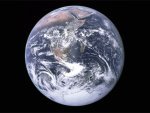Small Nuclear War Could Reverse Global Warming for Years
Regional war could spark "unprecedented climate change," experts predict.
Main Content

A nuclear bomb explodes in a test on the Mururoa atoll in French Polynesia in the early seventies.
Photograph from AP
Published February 22, 2011
Even a regional nuclear war could spark "unprecedented" global cooling and reduce rainfall for years, according to U.S. government computer models.
Widespread famine and disease would likely follow, experts speculate.
During the Cold War a nuclear exchange between superpowers—such as the one feared for years between the United States and the former Soviet Union—was predicted to cause a "nuclear winter."
In that scenario hundreds of nuclear explosions spark huge fires, whose smoke, dust, and ash blot out the sun for weeks amid a backdrop of dangerous radiation levels. Much of humanity eventually dies of starvation and disease.
Today, with the United States the only standing superpower, nuclear winter is little more than a nightmare. But nuclear war remains a very real threat—for instance, between developing-world nuclear powers, such as India andPakistan.
To see what climate effects such a regional nuclear conflict might have, scientists from NASA and other institutions modeled a war involving a hundred Hiroshima-level bombs, each packing the equivalent of 15,000 tons of TNT—just 0.03 percent of the world's current nuclear arsenal. (See a National Geographic magazine feature on weapons of mass destruction.)
The researchers predicted the resulting fires would kick up roughly five million metric tons of black carbon into the upper part of the troposphere, the lowest layer of the Earth's atmosphere.
In NASA climate models, this carbon then absorbed solar heat and, like a hot-air balloon, quickly lofted even higher, where the soot would take much longer to clear from the sky.
Reversing Global Warming?
The global cooling caused by these high carbon clouds wouldn't be as catastrophic as a superpower-versus-superpower nuclear winter, but "the effects would still be regarded as leading to unprecedented climate change," research physical scientist Luke Oman said during a press briefing Friday at ameeting of the American Association for the Advancement of Science in Washington, D.C.
Earth is currently in a long-term warming trend. After a regional nuclear war, though, average global temperatures would drop by 2.25 degrees F (1.25 degrees C) for two to three years afterward, the models suggest.
At the extreme, the tropics, Europe, Asia, and Alaska would cool by 5.4 to 7.2 degrees F (3 to 4 degrees C), according to the models. Parts of the Arctic and Antarctic would actually warm a bit, due to shifted wind and ocean-circulation patterns, the researchers said.
After ten years, average global temperatures would still be 0.9 degree F (0.5 degree C) lower than before the nuclear war, the models predict.
Years Without Summer
For a time Earth would likely be a colder, hungrier planet.
"Our results suggest that agriculture could be severely impacted, especially in areas that are susceptible to late-spring and early-fall frosts," said Oman, ofNASA's Goddard Space Flight Center in Greenbelt, Maryland.
"Examples similar to the crop failures and famines experienced following the Mount Tambora eruption in 1815 could be widespread and last several years," he added. That Indonesian volcano ushered in "the year without summer," a time of famines and unrest. (See pictures of the Mount Tambora eruption.)
All these changes would also alter circulation patterns in the tropical atmosphere, reducing precipitation by 10 percent globally for one to four years, the scientists said. Even after seven years, global average precipitation would be 5 percent lower than it was before the conflict, according to the model.
In addition, researcher Michael Mills, of the National Center for Atmospheric Research in Colorado, found large decreases in the protective ozone layer, leading to much more ultraviolet radiation reaching Earth's surface and harming the environment and people.
"The main message from our work," NASA's Oman said, "would be that even a regional nuclear conflict would have global consequences."


